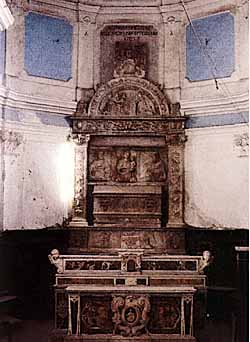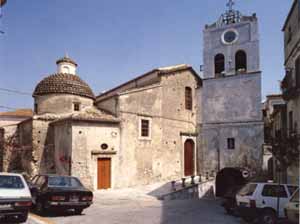The
Matrice church
(Centre
of Caulonia – Piazza Mese)
“Being derelict and impassable, Bernardino Viterbo
Protopapa, by wish of the Count Vincenzo Carafa, demolished
it and built it again in 1513: the reconstruction work began
on the 11th of May of the same year”. Once rebuilt,
the Matrice church, otherwise known as “Cattolica”, became one
of the eleven Protopapale churches belonging to the Dioceses
of Gerace, under the name of Santa Maria Assunta. Inside, it
is divided into three naves and its decorations are in 1700s
style. The sarcophagus of Vincenzo Carafa is worthy of attention,
built in 1488 according to Geronimo II’s plans and placed behind
the main altar in 1637.
|
|
 coat of arms
of the Carafa family
coat of arms
of the Carafa family |
|

Matrice church
Sculpted in white marble, the mausoleum presents “a
linear architectural plan in Renaissance style”, it has a predella
(whose “pretil”, lath and lower part of an altar-piece are in
Longobard style), two pillars complete with architrave and lunette.The Cristo Morto is portrayed in the predella between
two adoring angels.
|
|
The sarcophagus sits between the two pillars surmounted by three
panels portraying the Madonna and Child, and, on either side,
Saint Peter and Saint Andrew. Lastly, in the lunette, the Annunciation
is portrayed.
Visible on the sarcophagus and on the base of each
pillar, is the coat of arms of the Carafa della Spina family,
from whom descended arch-priests, bishops, cardinals and a Pope,
the Pope Paolo IV, who is remembered as being one of the most
turbulent Popes to sit in the throne of Peter. This monument,
after undergoing an inspection by the Superintendency for Antiquities,
was declared a national monument. Also the main altar is worthy
of notice, built in white marble with the pulpit and choir in
walnut. |




